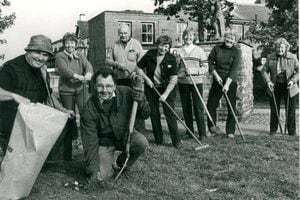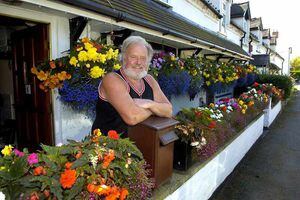'It's not all about hanging baskets' - 60 years of Staffordshire's Best Kept Village contest
It started 60 years ago before lawnmowers had motors and hanging baskets were confined to pictures on the lids of chocolate boxes.

A lot about the world has changed since then but, in spirit, the Best Kept Village competition has remained indomitably the same.
The competition was launched in the summer of 1956 by the newly set-up Community Council of Staffordshire. Its aim, set down in the council's annual report of 1956-57, was 'to give an incentive to the countryman to take an ever increasing pride in his own village and its immediate surroundings.'
It was decided to run the competition on a village basis although it was sponsored in each case by the local parish council. Forty-three villages entered in that inaugural year.
Judging took place between June 16 and July 16 and for the preliminary heats the county was divided into four areas: north, central, south-east and south-west.
The judges selected the best village - or at their discretion, two villages - for each area. They were, in the north, Barlaston, for central, Denstone and Weston-on-Trent, for the south-east, Elford and King's Bromley; and in the south-east, Cheslyn Hay and Himley.
Judging of the finalists was carried out by a different panel of judges, including the Secretary of the Staffordshire branch of the Council for the Preservation of Rural England, the chairman of the Staffordshire Federation of Women's Institutes, the president of the Staffordshire Parish Councils' Association, the county planning officer and county surveyor.
Though closely contested, Denstone was declared the unanimous winner and the board recorded their hearty congratulations.
In discussions prior to the competition's launch, it was felt that villages in the county's mining areas would find it difficult to compete with those in rural areas of natural beauty.
The annual report notes: "It was, therefore, gratifying to find that Cheslyn Hay took such pride in their village that, by dint of a community effort, it reached the final. The judges considered that the highest commendation had been earned by this mining village for its fine achievement."
Sixty years on, that ethos remains. Chris Welch, chief executive of the Community Council of Staffordshire, says: "We try not to be overwhelmed by the pretty-pretty villages. We're not looking for hanging baskets.
"The idea is to dig a little deeper and find out what the degree of involvement is. Weston, for example, is an intrinsically nice-looking village but we want lots of people and groups to be involved in the process.
"The competition is a really useful way of helping to build community spirit and pride in a place. That's the the benefit of it really. It acts as a nucleus to get people discussing their environment."
He gives an example of one of the benefits. About six years ago Yarnfield, which hadn't entered the competition for some considerable time, was having problems with anti-social behaviour. The community council's village agent, who was working with residents on the problem, encouraged them to enter the event again.
The experience brought the village together and they continued their involvement
The competition is judged by a pool of around 70 volunteers, many of whom have been involved for more than 30 years.
No qualifications or experience is necessary although volunteers are brought together and given an understanding of what is important.
Visually, they are noting the appearance of churchyards, pub surrounds, street furniture like bus shelters and telephone boxes, and looking out for signs of litter and dog fouling.
A group will visit three or four villages in a day, each with its own lead judge, who will be the most experienced.
Chris Welch says: "The judging is not scientific. Obviously we do our best to iron out any idiosyncratic judging. But some villages will have been judged by 16 different people by the end of the competition, so it works out fairly."
The first trophy was an impressive wrought-iron affair created at Endon Forge, which incorporated the Staffordshire Knot and stood on an oak post.
It was presented to the Community Council byAlderman Alfred Owen, of the Black Country manufacturing firm Rubery Owen, which is still a sponsor of the competition. It was named the A.G.B. Owen Trophy and a bronze plate on the post permanently recorded the name of the winning village each year.
Very soon, however, other sponsors got in on the act and after the second year, there was no longer one overall winner, but several from different parts of the county. Firms wanted to be associated with the competition in their area and donated their own trophies.
Then it was felt fairer to split the competition by size, into small, medium and large villages, but that became unworkable after a while and now just small and large categories remain.
The number of entrants has remained fairly steady, at around the mid to high 50s, although this year, given the competition's milestone anniversary, there is a push to nudge the figure up to 60.
More than 200 villages have entered over the past six decades, with a strong concentration in the central and southern part of the county.
Efforts have been made to to get urban villages on the edge of Stoke-on-Tent and Burton interested but it has not happened. Around 20 years ago a handful of villages in the Moorlands and around Newcastle under-Lyme took part but are not as active nowadays.
The first round of judging takes place in May, followed by another in June. Second visits are made and 10 villages eventually selected for the final, which takes place in July.
The contest has became part of the rural social calendar. Committees are set up and clean-up sessions organised. The project becomes part of a daily routine, even nightly in some cases.
In May1984, in a bid to hold on to their Best Kept Village title, members of the Codsall and District Civic Society, armed with brooms, trowels and clippers, kept a nightly vigil at the Lone Singer Gardens, ahead of the judging.
But that's unusual, says former geography teacher William Read, who has been a judge since 1972 when the Community Council decided it wanted representatives from local sixth-forms on the judging panels.
Then 18, and at Graham Balfour High School in Stafford, he was delighted to have been chosen and 42 years on, continues to enjoy his involvement.
He said: "You look for things people have done that no one's been paid to do, like mowing the grass verge in front of their houses and sometimes putting flower beds down.
"Some villages have turned their old British Telecom phone kiosks into mini-libraries or information points. It's about making the most of something."
There have been two remarkable winning streaks in the last decade, with both Weston (2004-08) and Haughton(2011-14) notching up four victories in a row. Less experienced teams must sometimes wonder whether it's worth the bother.
But Mr Read says: "It's true that Haughton and Weston have done very well in recent years but that sort of run can be broken. I remember when Hopton entered for the first time in 1989, they came from nowhere and won, and won again a couple of years later, so it can be done."
An important part of the competition remains the element of surprise, with the timing of the judges' visits kept a closely guarded secret. "Once or twice the judges have turned a corner to find people furiously sweeping up the paths as word has got round we're there. But it's all part of the fun of what we do."










